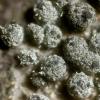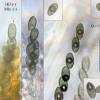
01-01-2026 18:35
Original loamy soil aside a artificial lake.The co

31-12-2025 19:27
Collected from loamy soil, at waterside (completel

30-12-2025 16:44
Pascal DucosBonjour,Une anamorphe rose stipitée, très nombre

30-12-2025 17:14
 Bernard CLESSE
Bernard CLESSE
Bonjour à toutes et tous,Pourriez-vous aider Albe

29-12-2025 10:15
Hulda Caroline HolteHello, I found and collected this propoloid ascom

30-12-2025 09:04
Hello.A Pyrenomycete sprouting sparsely but very d

29-12-2025 17:44
Isabelle CharissouBonjour,J'aimerais savoir si d'autres personnes au
Have you some idea about this strange roundish, densely gregarious,
uniperitheciate pyrenomycete, up to 0.7-0.8 microns in diam, covered by a
conspicuous white material? It was collected on the underside of a woody piece
(perhaps Salix).
The asci have a little refringent apparatus IKI and Melzer negative and the ascospores
(2-guttulate in H2O) have any germ slit (or it is very inconspicuous).
When I began to study it, my material was very damaged and for it I cannot do a good description but I see any dark peridial setae of Coniochaeta-type
Many thanks again
Enrique

I agree with you this likely a Coniochaeta. They don't all have conspicuous setae, you should check the ostiolar region in a crush mount, you may find small setae.
Regarding a possible species name I have no idea! Maybe Andy?
Good luck!
Jacques
But the spores have not conspicuous germ-slits as the typical Coniochaeta species!
I can't to study more the perithecia because they are dead

Andy

Peter

your species reminds me somewhat of Boliniaceae, especially if you look at the spores on the left site (2guttulate, as you described). Arrangement in Asci is similar to that in C. microspora, for example. Only the apical apparatus does not fit to "Camarops". I do not know Boliniaceae very well but I think you should look there.
regards,
björn

Andy

regards,
björn

Andy
cheers




